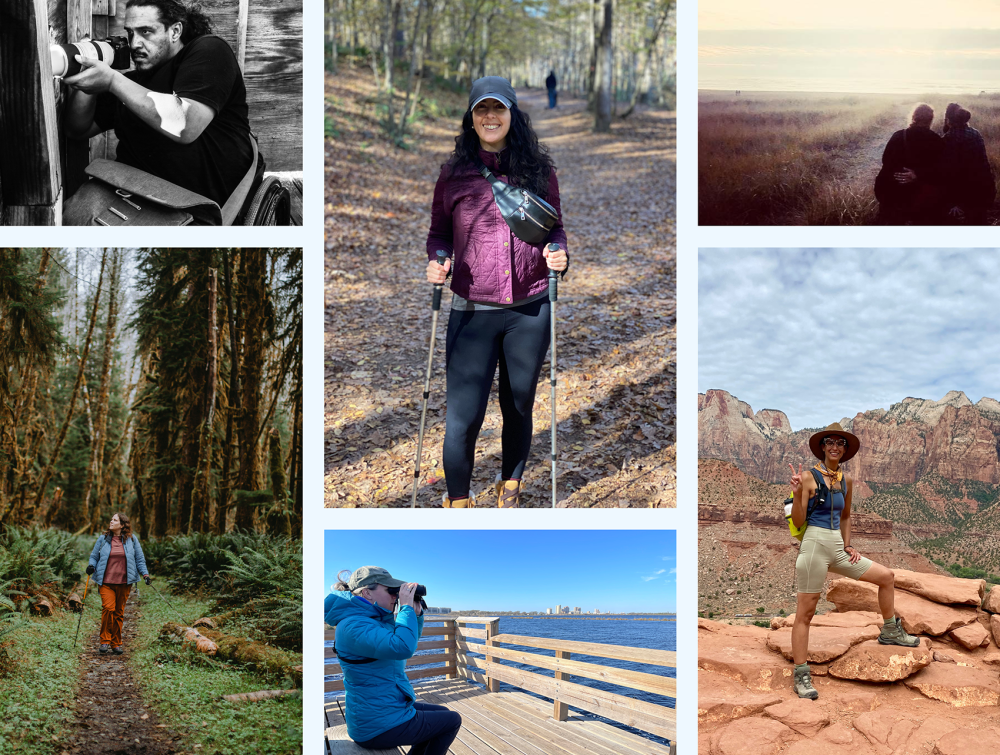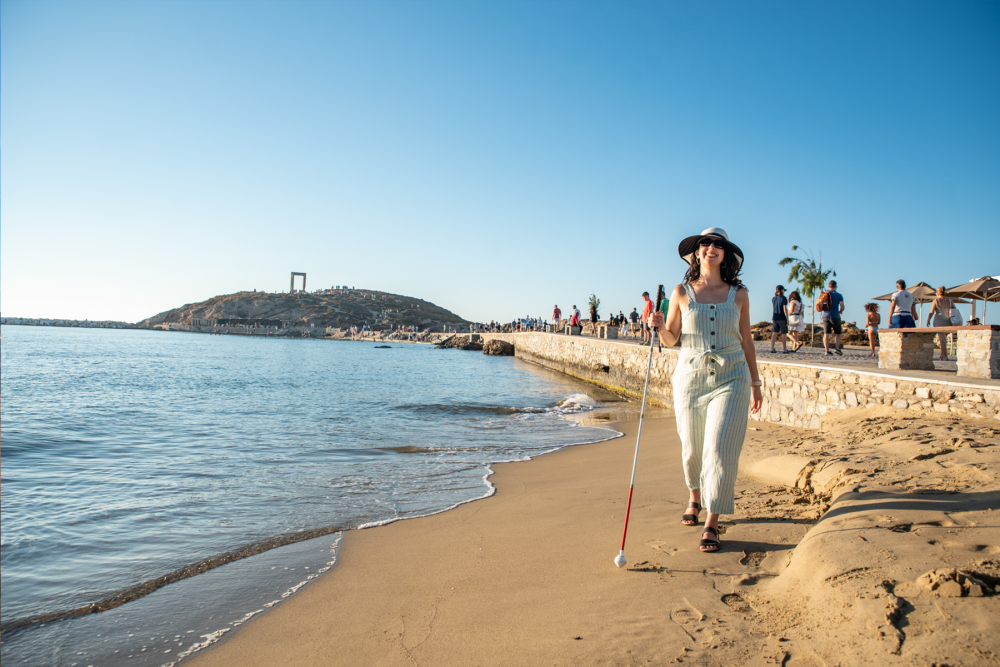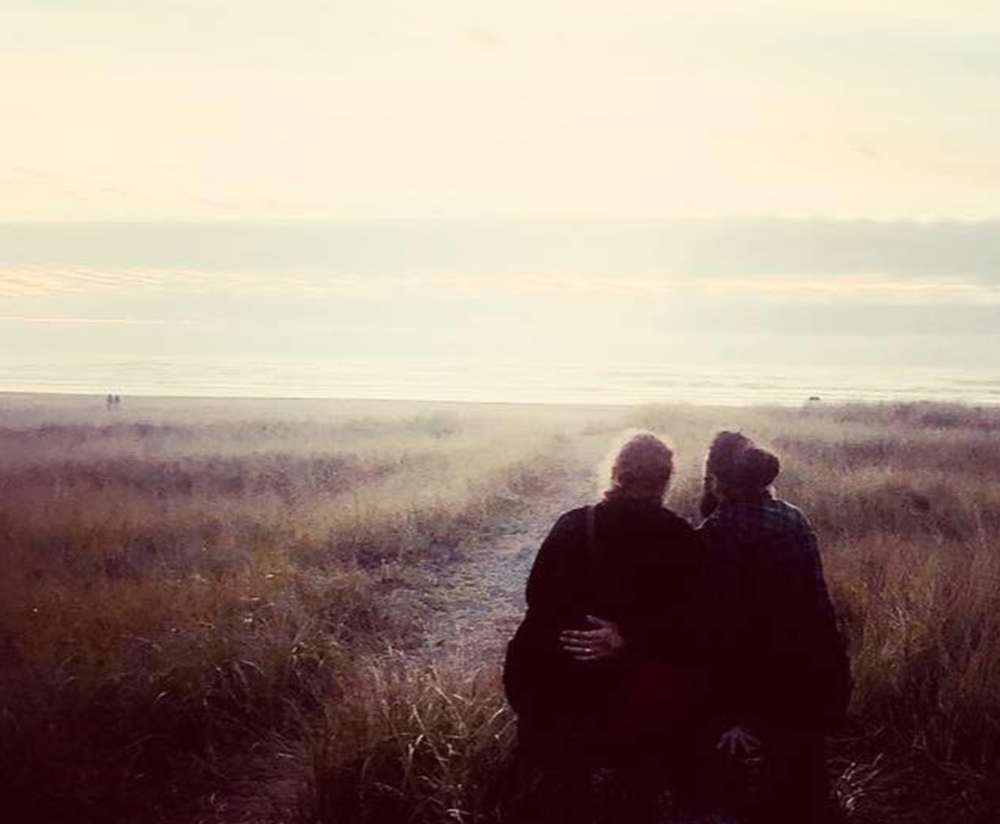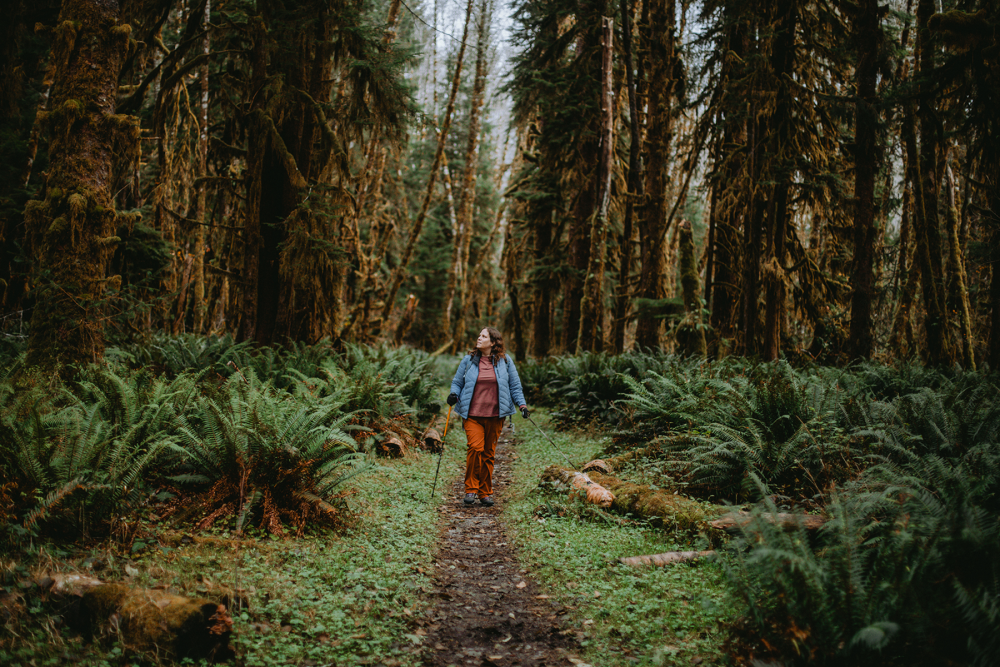7 disability advocates talk about accessibility and ableism outdoors

Image collage caption: Upper left: Joseph Saunders at LLELA Nature Preserve near Dallas, TX, photo: Holla Bing; upper middle: Catarina Rivera hiking near Atlanta, GA; upper right: Anni and John Furniss sitting in Long Beach, WA; lower left: Syren Nagakyrie hiking with their service dog through a redwoods forest, photo: Eddie Bauer/Elise Giordano; lower middle: Freya McGregor birding from a bench at Gulf State Park, AL, photo: Patrick Oaks; and lower right: Tatsuko Go Hollo standing on red boulders in Zion National Park.
For many, experiencing the outdoors has more to do with accessibility and ableism, rather than “ability”
When we talk about outdoor adventures, we usually envision breathtaking landscapes, thrilling hikes, or serene lakes. But for people with disabilities, accessing and enjoying the wonders of nature can be a real struggle.
In the United States alone, more than one in four adults have some form of disability, with Black and Indigenous people having higher rates of disability. Disabilities can range from mobility differences to neurodivergence. It’s important to recognize that people with disabilities are a diverse group with a wide range of needs, and ensuring access to the outdoors and welcoming spaces remains an ongoing challenge for many.
Unfortunately, outdoor environments often fall short in terms of accessibility.
Some of the obstacles facing people with disabilities: uneven terrain, steep inclines, a lack of ramps and handrails, narrow pathways that aren’t wheelchair-friendly, absence of closed captioning on video exhibits and maps without tactile or audio features. While federal agencies are making efforts to address some of these issues, there is much work to be done in improving access to all types of parks and public lands.
Aside from physical obstacles, ableism also plays a significant role in making many feel unwelcome in outdoor spaces. These experiences arise from society’s narrow definition of capability and the absence of inclusive practices in outdoor recreation. People with disabilities are also often left out of conversations regarding climate and environmental justice, resulting in inaccessible systems and policies. In recent years, online communities and organizations like Disabled Hikers, Unlikely Hikers, Wildability and Disabled & Outdoors have emerged to challenge this status quo.
We spoke with seven people involved in this advocacy work about their connections to the outdoors, how they find joy in nature and their fight for a more inclusive outdoors and better access to parks and public lands.

Catarina (she/her) is a public speaker, DEIA consultant and content creator who uses her platforms to smash disability stigmas and promote awareness, inclusion and accessibility. For Catarina, who is blind and deaf, the outdoors has always been a space of freedom and sensory experiences. Whether she is feeling the warmth of the sun or enjoying the scents and textures of nature, it offers a much-needed break from technology and an opportunity to reconnect with herself. She also cherishes outdoor moments of public celebration and community, whether that’s salsa dancing or exploring food markets.
However, Catarina acknowledges the challenges and barriers faced by people with disabilities in outdoor activities—from uneven terrain in hiking areas, to inaccessible trail markers, to beaches that can’t be reached by wheelchair.
Catarina has also experienced ableist and unaccommodating attitudes, including from a guide who wouldn’t provide a safe place to keep her hearing aids from getting wet.
“I’ve noticed a lack of education with activity providers on how to work with disabled people, how to communicate. […] Disabled people are really resourceful, but some people don’t even want to try working with us.”
These kinds of obstacles can be addressed in part by involving the disability community in all aspects of planning and managing outdoor spaces. There’s also a need for policymakers and funders to take action and allocate budgets specifically for improving accessibility in new and renovated projects.
It’s important to go beyond accommodating people with disabilities, says Catarina, to creating truly inclusive environments that benefit everyone’s mental and physical well-being. By working together, involving the disability community and committing to disability justice principles, Catarina believes we can transform outdoor spaces into inclusive havens that allow everyone to fully enjoy the wonders of nature.

John and Anni Furniss, Washington
Anni (she/her) and John (he/him) Furniss have been together 11 years and married for almost eight of them. John is a woodworker who shares his incredible work on social media and on his blog, and Anni is a mixed media artist. John is blind and has epilepsy and chronic pain as a result of a traumatic brain injury. Anni has a genetic condition called hypermobility that affects connective tissue, degenerative bone disease and anxiety and sensory issues. They both share a deep connection with nature.
The Furniss’ nature adventures began with a trip to the ocean—and some trepidation from John, a Midwesterner who had never visited before. But once he was able to absorb the beauty of the water through his non-sight senses—mostly hearing and touch—it unlocked a new world of experience in the outdoors.
“[John] said it wasn’t what he expected. He was pleasantly surprised at the pull of the waves on his ankles and how his toes sunk into the wet sand with each receding current. He felt the vastness of the water that went on and on. The sound of the tide, the wind and the gulls were a great soundtrack.” – Anni
Since then, John and Anni have enjoyed numerous nature outings, developing a special appreciation for places like a local trout hatchery and park called Columbia Springs that offers accessible trails, tactile art and a peaceful environment away from traffic noise.
They’ve faced obstacles in nature, too: unkempt trails full of tripping hazards, steep slopes without hand railings, visitor information lacking Braille or audio descriptions. More accessible facilities are vital to creating more inclusive environments for the disability community.
There is also work to be done on the culture front. John and Anni point out that park visitors should be more considerate of people with disabilities. That includes moving aside or approaching slowly, understanding that not everyone is the same.

Syren’s (they/them) connection to the outdoors started in childhood—from hanging out in their yard, listening to birds and feeling a sense of belonging in nature. As a child, Syren was constantly sick, and because of a combination of factors— their family didn’t have much money, and there was little social awareness about disabilities – it wasn’t possible to go out and do typical outdoors activities like sports or camping. Syren is neurodivergent and has hypermobile Ehlers-Danlos Syndrome (a connective tissue disorder that affects many organs and ligaments and causes frequent joint dislocations and chronic pain) and Postural Orthostatic Tachycardia Syndrome (an autonomic nervous system condition that also affects blood pressure and circulation).
Later, Syren got into hiking. But as they explored supposedly “accessible” trails around Washington, they often encountered obstacles that hadn’t been mentioned on blogs and park websites. This led to the creation of their blog, “Disabled Hikers,” which offers detailed trail guidance with more context and nuance, raises awareness about issues faced by hikers with disabilities and serves as a platform for organizing group hikes. Disabled Hikers became a nonprofit in 2021 and is a growing national organization, with dozens joining their hikes and online conversations.
Syren emphasizes that the guidelines for making sure places are accessible are not always sufficient. We must work with disabled folks to understand what’s really needed. There is a lot of wisdom and experience in the disabled community that can inform the creation of truly inclusive outdoor spaces.
“There’s an unspoken perception that all hikers are abled bodied – but disabled people hike too and there are many ways we do it. We are challenging ableism that exists everywhere. And while it does start with providing good trail info and increasing the number of accessible trails – we also have to address the culture.”
For Syren, it comes down to this: Nature is fundamental to our well-being as humans, and everyone deserves access to it—not just a privileged few. Cutting people off from nature means cutting them off from a significant aspect of their identity.
Disabled people, according to Syren, adapt to challenges in a similar way ecosystems adapt to disturbances and disasters. Once people learn to recognize this thread everywhere, they’ll see that disability is anything but “unnatural,” and gain a more holistic understanding of what it means to have a life-supportive environment.
Helping Disabled People Find Belonging Outdoors
Like so many others, I’ve found that being in nature has helped me get through the most difficult periods of life, but I’ve had to fight hard to access the outdoors. I didn’t grow up particularly outdoorsy. My family was poor — one parent disabled and the other working full time — and I was sick. I spent the majority of my childhood at hospitals and doctor’s offices due to illness or unable to walk due to disability-related injury. I couldn’t participate in physical education, field trips or summer camps.
But I still felt an innate connection with the natural world. I slowly walked through the yard, noticing the birds and bugs and flowers that surrounded me. When the scorching Florida heat kept me indoors, I gazed at the moon on cool nights. I didn’t have big adventure stories to share with the kids at school, but I did have the insights of close attention to the land.

This approach to experiencing nature is now popularized as “mindfulness” or “forest bathing” or “slow hiking.” But for many disabled people, slow, attentive experiences are the only way to experience nature. People often push past me on the trail, frustrated with my slowness on the way to their destination. What they don’t know is that while I’m paying close attention to my body, I’m also experiencing an entire world right where I am — noticing the life cycle of lichen, the small mammals in the brush, and the way the light and air feel on my skin. It is so easy to miss these things when people rush by.
Many people with disabilities don’t get to experience outdoor recreation at all. There is ample evidence that time in nature provides a range of physical, emotional and mental benefits and can enhance a sense of belonging. Yet the people who need these benefits the most – the disability community — are often excluded from the outdoors. But this doesn’t have to be the case. The inaccessibility of built environments, the lack of affordable resources and information and the overall disregard of disabled folks by non-disabled people are the primary barriers to the outdoors, not a disabled person’s abilities.
When I started exploring outdoor recreation in my mid-20s, I quickly encountered all of these barriers. Groups I wanted to join said my participation was too risky, the gear I needed to support my body was too expensive, and finding information on accessible features was nearly impossible. These frustrations have remained consistent for nearly 15 years, but they came to a head when I moved to Washington state.
I was eager to experience the Olympic Peninsula when I moved here and immediately set to researching trails. While there is far more information available in Washington compared to many other states — thanks in large part to Washington Trails Association — I still could not find the detailed information that I needed. I often received information that was not accurate for my needs from non-disabled hikers. For example, when I asked for easily accessible coastal trails, hikers recommended the Kalaloch coastal trails and the Cape Flattery Trail as very easy. But each of the Kalaloch trails presented accessibility issues: a steep, slippery grade or piles of drift logs to navigate, which is impossible for someone with limited mobility. The Cape Flattery Trail has around 100 steps and 200 feet of elevation gain in three-quarters of a mile, which is not easy for someone with cardiopulmonary concerns or joint pain. (Thank you to the Makah craftsman who leaves walking sticks at the trailhead for donation. Note to disabled hikers: If you see sticks left at a trailhead, the trail is probably steep or slippery.)

Knowing what to expect before going for a hike is critical for disabled people. Photo by Olympic National Park.
In the spring of 2018, I set out on a different segment of a trail system that I was already familiar with, expecting it to be an easy hike. I immediately encountered numerous barriers that weren’t listed in any of the guides, including steep stairs and a narrow, scree-covered path along a sharp drop-off. While these features are likely inconsequential to non-disabled hikers, they were a major safety concern for me, and I had no way of knowing they were there. Turning around would have been equally difficult, so I continued on, eventually making my way back to the car, exhausted and in pain.
If there is one thing that I wish all hikers knew, it’s that building accommodations and universal access into the community benefits everyone.
The culmination of these experiences inspired me to start Disabled Hikers. As an organization by disabled people for disabled people, Disabled Hikers is working toward building a community of people who feel like they belong outdoors. We help to provide access to information and resources through detailed trail guides and reviews, lead group hikes for the community and advocate for accessibility and inclusion in the outdoors. Disabled Hikers is committed to creating space for disabled folks to take the lead and make their own decisions, because supporting individual autonomy while nurturing community interdependence is so important.

If there is one thing that I wish all hikers knew, it’s that building accommodations and universal access into the community benefits everyone. There are many ways to create accessible and inclusive opportunities for outdoor recreation, and it starts with considering the way people approach disability and the outdoors. I am not advocating for paving over the wilderness. But I do ask non-disabled people to consider how they frame their outdoor experiences and think about who is being excluded. What does it mean if the epitome of outdoor recreation — extreme mountaineering or kayaking, for example — is something that few people can ever experience? (Side note: The few disabled folks who are able to accomplish such adventures are not doing it to inspire you.)
The emphasis on quantity over quality in the outdoors, for example, getting the most miles in the least amount of time or accomplishing the most extreme adventures in remote places, reinforces harmful narratives about productivity and nature as a resource. These narratives harm all of us — disabled and non-disabled people alike. Taking a stroll through an urban park on a lunch break is just as valid as backpacking in the wilderness, and indeed may have just as much to teach about being in nature.
Disabled folks have a lot to teach people about taking life slow, caring for ourselves and each other, and making sure everything we offer is accessible to all. The sidebars to this article include some suggestions for making outdoor spaces more accessible. I encourage you to talk with disabled people in your community about what they need. Advocate for accessible structures and trails in local parks, improved transit options, and more information and resources for the community.
How You Can Help
Trail information that disabled people need
When you are providing information about a trail, in trip reports for instance, here is the information that will help disabled people decide if the trail is right for them. You may not be able to provide all of this information. The most important thing is to be as specific and detailed as possible. Disabled people need to know what is accessible and inaccessible about a place.
Getting there: Road conditions, type of roadway, how curvy or narrow. Information on number of accessible parking spots and available amenities (accessible restrooms, potable water, picnic areas) at the trailhead. This information is often overlooked, but for people driving accessible vans or those who have difficulty navigating roadways, it is essential. Include public transportation options. Note if cell phone service is available — this is an important safety consideration.
Trail design and conditions: Cross-slope and running slope, width, surface of the trail. Obstacles and barriers such as rocks or downed trees; information on muddy or slippery areas. Provide details on boardwalks, bridges or stairs (how many, how long, how steep, what material). Make note of places to rest (benches, tables, a particularly nice log).
Elevation: Detailed elevation information along the entire trail, to include length and grade of each elevation change as well as total elevation change. Provide an elevation profile. If it is a loop trail, list the direction of the elevation change.
Segments and trailheads: Detailed information for each segment with the access point clearly defined.
Difficulty: Be specific about what “easy” or “hard” means for you. Give context for your opinion — are you an average non-disabled hiker, an experienced trekker, or someone who climbs 14,000-foot peaks on the weekend?

People on a Disabled Hikers trip pass through the gate blocking the Olympic Hot Springs Road. A park ranger had to open the gate to allow access. This event led to the widening of the path around the barrier. Photo by Syren Nagakyrie.
Simple changes that improve access
Improved signage: Provide information at trailheads about the surface, grade, width and elevation of the trail, along with a map. This gives disabled people the opportunity to make a more informed decision right at the trail. Include Braille and audio descriptions when possible.
Install benches and mark them on the map: A safe place to sit that doesn’t require going off-trail makes a trail much more accessible. Knowing when I’ll be able to sit makes a huge difference in whether I attempt a trail or not.
Widen trail barriers: Many trails would be accessible if the entrance was wider or the gate adjusted to make maneuvering easier. It is understandable that land managers are concerned about illegal use, but it also prevents use for people who use mobility aids or are unable to navigate tight corners.
Barriers at sitting height: Visual barriers at sitting height are a common experience on allegedly wheelchair-accessible trails. Have at least one area with a lower barrier or install a barrier you can see through. Note barriers on information materials — it is very frustrating to make the effort only to be blocked from seeing something.
Notes on language
The majority of the disability community prefers identity-first language, such as disabled person. Person-first language is also acceptable, such as person with a disability. Please avoid all euphemisms such as “differently abled,” “special needs,” or “handicapable.” Do not refer to wheelchair users as “wheelchair bound”; wheelchairs are a source of mobility and freedom, not something people are chained to.
When referring to features such as restrooms or parking spaces, it is preferable to describe them as accessible rather than handicapped, for example, an accessible bathroom stall. Handicapped is considered a slur. Cripple is also considered a slur when used by non-disabled people, but it is being reclaimed by the disability community. Physically disabled folks may use the word to describe themselves. When in doubt, always ask someone which words they prefer, and follow their lead.

A hiker takes a scenic rest along the Green Lake tail. Photo by Katie Hoynes.
Hiking Mindfully
Mindful hiking can benefit everyone, especially now that many hikers must stay closer to home. Here are a few tips for paying attention to the small things in nature, whether on a stroll around your neighborhood or in the backcountry.
Breathe: Start every walk or hike with a few deep, calming breaths. Take a moment to look around you. What trees, plants and animals are present?
Feel: Feel the way your feet touch the ground. Know that whether you are on sidewalk or trail, the ground is under your feet (even concrete is made of earth). How does the wind or sun feel on your skin?
Notice: Challenge yourself to notice as many of one plant, animal or fungus as you can – how many birds, how many dandelions, how many mushrooms? Find the nearest tree and commit to standing or sitting there for a few minutes every day. Notice the bark, the way the tree moves, the plants and animals that interact with it.
Gratitude: Nature surrounds us wherever we are, even in the city. Make a practice of thanking everything and everyone that is working to keep you alive — the trees producing oxygen, the earth filtering clean water, the plants producing food and the incredible biodiversity of the planet without which we could not survive.
Syren Nagakyrie (they/she) is a long-time disabled activist and community builder. They are the founder of Disabled Hikers, disabledhikers.com. Syren is also the author of “The Disabled Hiker’s Guide to Western Washington and Oregon: outdoor adventures accessible by car, wheelchair, and foot,” to be published by Falcon Guides.

Contact Us
Washington Trails Association
705 2nd Ave, Suite 300
Seattle, WA 98104
Get Trail News
Subscribe to our free email newsletter for hiking events, news, gear reviews and more.
Sponsors
Trails for everyone, forever
https://www.wilderness.org/news/blog/7-disability-advocates-talk-about-accessibility-and-ableism-outdoorshttps://www.wta.org/news/magazine/features/helping-disabled-people-find-belonging-outdoors
